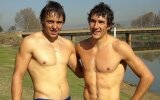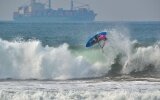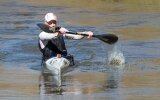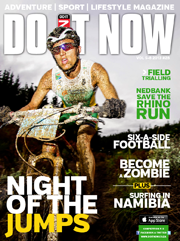- Magazine
- #readityourway
- Weekly Stories
- #shareyourstory
-
Adventure
- Abroad Travelling
- Africa Travelling
- Events
- Expos & Shows
- Festivals
- Fishing
- Free Diving
- Gliding
- Horse Riding
- Inspiring People
- Islands Travelling
- Kite/Windsurfing
- Motorbiking
- Motorised Water Sports
- Mountaineering
- Mountain Biking
- Off-road 4x4
- Off-road Motorbiking
- Paddling
- Performance Driving
- Photography
- Rock Climbing
- Rollerblading
- Sailing
- Scuba Diving
- Skateboarding
- Skydiving
- Snowboarding & Skiing
- Surfing
- Swimming
- Trail Running
- Wakeboarding
- Waveski Surfing
-
Sport
- Adventure Racing
- Fishing
- Free Diving
- Gliding
- Health & Fitness
- Horse Riding
- Inspiring People
- Kite/Windsurfing
- MMA
- Motorbiking
- Mountain Biking
- Multi-sport
- Off-road 4x4
- Off-road Motorbiking
- Paddling
- Performance Driving
- Photography
- Road Cycling
- Road Running
- Rock Climbing
- Rollerblading
- Sailing
- Scuba Diving
- Skateboarding
- Skydiving
- Snowboarding & Skiing
- Surfing
- Swimming
- Rugby
- Trail Running
- Triathlon
- Wakeboarding
- Waveski Surfing
- Lifestyle
- Calendar
Basics - Keeping Warm and Saving Energy in Winter
Words: Deon Breytenbach | Photos: Deon Breytenbach & Helena Pienaar
Topic:
Paddling
Winter is here so it's time to open the cupboard and check all your winter toys. If you stored them correctly, they might only need a little TLC, but sometimes gear reaches the point where you need to let it go and replace it with something that will keep you smiling when it's chilly on the water. But more importantly, you need to keep Jack Frost's icy grip away from your body and off your mind.

Taking the time to pack your gear correctly for storage of any length of time is well worth the effort. Here are a few basic things to do and think about, to help you keep your equipment in good shape when in storage. When storing any dry gear (excluding PVC or vinyl materials) I would recommend the following for use before storage and especially when you take them out for your first winter sessions:
Penguin Sport Wash - This is a residue-free laundry detergent, designed specifically to keep high-performance fabrics performing like the day you bought them. In addition to using this non-allergenic detergent to prolong the life of your high-performance fabrics on a daily basis, a last wash before storage will help a lot, as this ensures that no oils, sunscreen, dead skin cells or any other nasties can cause damage while you are playing in the summer sun.
Penguin Permanent Water Guard - This restores the water repellent finish to all water repellent and waterproof, breathable fabrics, making it ideal to further protect your gear when in storage and get it into full swing after the winter. Make sure you rinse or wash the top with a residue-free detergent like Sport Wash. Any residue from detergents or anything else will hamper the effectiveness of the bond that the treatment creates with the material. Lay your top on a flat surface and spray the PWG on as evenly as possible. When you hang it up to dry, hang it upside down as this helps to get any excess PWG on the top parts, like your shoulders, where there is the most wear and tear. If you see that after a while the water is no longer beading on the surface of the materials, re-apply some PWG. If you find that this is only on a couple of spots, like your shoulders, then treat that area and not the whole top.
UV Protector - This stuff is brilliant, sunscreen for clothes. It protects the fibres in your gear against UV damage, especially while it is hanging out to dry. If you read the care instructions on most high-performance garments or gear, pretty much all of them make a point of saying 'do not dry in direct sunlight'.
Your nearest Sportsmans Warehouse should stock all of the Penguin range. The only other brand I would bring anywhere near my gear is Nikwax, which is similar to and just as good as Penguin's products, but not always easily available.
If you treat latex seals with baby powder (talcum powder) before you pack them away, they should be hundreds after a quick spray with some pure silicone spray. If you didn’t powder them or they have stuck together, then pull them apart as carefully as possible and trim off the edges if they have started to perish. As soon as you have done that, lube them with some silicone spray. This is only a temporary solution because once they start to perish, it's only a matter of time before they break. In the meantime, contact your nearest kayak dealer to order some replacement gaskets.
Keeping dry
The key to a good winter paddle session is staying as warm and dry as possible. Therefore, the less energy your system has to waste on keeping warm, the more energy you will have to paddle with and enjoy your day on the water.
Step one is to stay dry, but with kayaking being a water sport this makes it rather tricky. The two most important toys for this are a splash deck and a dry/semi dry top.
Splash deck - I use a Seals Pro Rand deck and have found it to be the driest deck ever. If you can’t get your hands on one of these bad boys, I would opt for the Peak UK Whitewater deck, which is new and part of their 2013 line up and replaces the old Creek and Freeride decks.
Dry/semi dry top - This is the biggest staying-warm investment you should make - a dry top cag. When water sneaks in at your waist, neck and arms (wrists/biceps) when kayaking, you have two choices when looking at the gasket cags. Neoprene-only gaskets are more comfortable, as well as a bit tougher, but they will allow some water to sneak in and wet you. Latex gaskets are super tight and the way to go if you really need to stay dry. Most cags that have latex gaskets will have neoprene gaskets covering them, to help protect the latex gaskets. Please take the time to check the instructions on the cag you buy for care and adjustment instructions, especially with latex gaskets.

Something else that you need to do is to make sure that the cag you buy is breathable, otherwise your sweat will build up inside the cag and make you wet. Decent cags start at just under R2,000 and if you look after it, you will get several seasons out of it. I am very hard on my equipment, so if I can get two years out of a quality cag, most of you should be able to get at least double the life out of it.
When it comes to cags, we are spoilt for choice. The top choice that is available locally, if you are a grade 3+ paddler and running creeks, is the Peak UK Creeker. If you aren’t running the craziest water or the budget won’t allow, then opt for the Creek, then the Deluxe or Freeride. On hot days, I use Palm’s Zenith and for the winter sessions, the Surge. However, they are not that readily available in South Africa anymore - but we are working on it. To stay drier than this, you will have to invest in a full-on dry suit. Please do not buy a scuba diving dry suit because it is not designed for white-water use. Your best option would be the Creek One Piece from Peak UK.
Keeping warm
The garments mentioned will keep you dry, but to stay warm you will need to layer up. There are a million and one choices when it comes to base layers and luckily, they are all readily available throughout South Africa. I use First Ascent’s toys because they outperform any brand I have used before, and after several years of hammering their toys even my old gear still outperforms the new toys from different brands. The following are my recommendations:
Legs - On an average winter day, I use thermal long johns. For colder days or when I know I will be in and out of my yak a lot and need that extra bit of heat, I use Derma-Tec Long Johns.
Torso - For my top half, either polypropylene or Derma-Tec, as they are both brilliant. Seeing as we live in an age of accessorising, you can get some wicked extras to keep you warm and toasty.
Head - For your pip, a neoprene skull cap will not only help with ice cream headaches, but also with keeping your ears warm and aids in slowing the development of 'surfer's ear', which is exacerbated by very cold water. A proper white-water nose plug is killer and they are made locally by River Black Composites. Water sport earplugs will also keep water out and help slow the development of 'surfer's ear' or hopefully avoid it totally.
Hands - For your hands, you can either get neoprene gloves or a better choice would be a set of neoprene pogies (think oven mitts for paddles, but your hand and the paddle fit inside so that you don’t lose any feedback from your paddle, as is the case with neoprene gloves).
Towel - The last piece of awesomeness to get yourself is a First Ascent microfibre super towel. These little treasures dry you instantly and help you get into your trail pants super fast.
For some sneaky on-river tricks, check out my blog as it features tips and tricks, as well as some of the river gear recommendations. Oh yes, and the best way to stay warm while paddling in winter is by not swimming.
dinFO:
For more information, photos and links to other online resources, visit Deon’s blog: www.doitnow.co.za/blogs/deon-breytenbach.
|
|
|
|
|
Issue:
Issue 26 Jun '13
Contributor:
Deon Breytenbach
Related content
|
|
|
|
|
|
|
|
|
|











